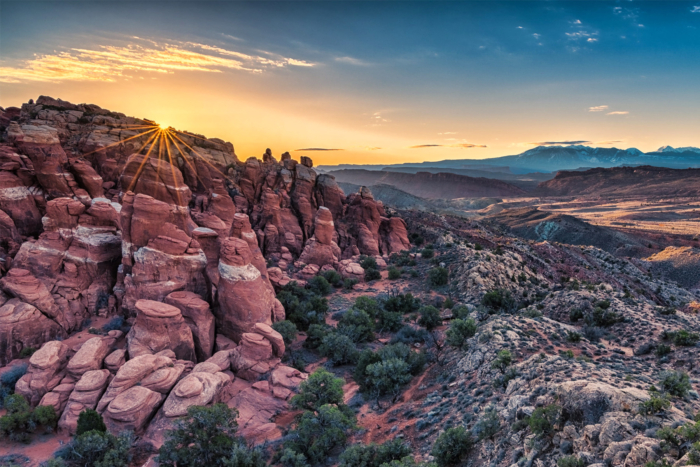A laser rangefinder is handy in all sorts of situations. But for hunters, in particular, it can make the difference between meat in the freezer and a missed opportunity.
And the following rangefinders can do just that. We’ve been careful to include budget-minded options as well as burly long-distance spotting machines. And you’d be surprised just how far some of these contraptions can spot.
Rangefinders are, of course, useful for a variety of folks. Golfers, archers, competitive shooters, long-range shooters, and photographers are among the many looking to delineate distances.
And although many rifle scopes do have rangefinding capabilities, hunting legalities for these scopes do vary across states. In this article, we focus on more hunting- and archery-specific uses for rangefinders and rangefinding binoculars.
Below you’ll find handheld rangefinders and a few rangefinder/binocular combos for use in the hunting field. Happy ranging!
Scroll through to see all of our recommended buys or jump to the category you’re looking for. Also, be sure to check out our handy comparison chart and buyer’s guide at the bottom of this article.
- Best Overall Rangefinder: Maven RF.1
- Best Budget Rangefinder : GoGoGo Sport VPro Rangefinder
- Best Rangefinder/Bino Combo: Vortex Fury HD 5000
- Best App-Supported Rangefinder: Leica Rangemaster CRF 3500.COM
- Best Rangefinder for Archers: Leupold Rx Full Draw 4
- Best Lightweight Rangefinder: Sig Sauer KILO2200BDX Rangefinder
- Best of the Rest: Bushnell 1700 Rangefinder
- Swarovski El Range 10 x 42
- Nikon ProStaff 1000i
The Best Rangefinders of 2023
Note: We chose distance to deer rather than simply using nonreflective distance, as many companies use this as a measurement.
Atmospheric conditions, landscape, and more can shorten or lengthen your ranging ability to nonreflective distances, so think of that number as less black-and-white and more variable.
Read our buyer’s guide below for more on reflective versus nonreflective distance, magnification, how rangefinders work, and what to expect.
- Distance to deer: 2,700 yds.
- Reflective distance: 5,000 yds.
- Weight: 10 oz.
- Magnification & objective lens: 7×25 mm
Pros
- Great magnification
- Solid power for the price
Cons
- Quite heavy
- Somewhat bulky
- Nonreflective distance: 6-650 yds.
- Reflective distance: 5-900 yds.
- Weight: 6.5 oz.
- Magnification & objective lens: 6×25 mm
Pros
- Good quality but cheap
- Lightweight
Cons
- Pretty short range
- Distance to deer: 5-1,600 yds.
- Reflective distance: 5,000 yds.
- Weight: 32.2 oz.
- Magnification & objective lens: 10×42 mm
Pros
- Super-far range
- Waterproof, fogproof, and shockproof
Cons
- On the heavy side
- Distance to deer: 1,500 yds. or more depending on conditions
- Reflective distance: 3,500 yds.
- Weight: 6.7 oz.
- Magnification & objective lens: 7×24 mm
Pros
- App compatible
- Great range
Cons
- Expensive
- Distance to deer: 6-900 yds.
- Reflective distance: 1,200 yds.
- Weight: 7.5 oz.
- Magnification & objective lens: 6x
Pros
- Archery-specific design
- Quite light
Cons
- Not the best range
- Distance to deer: 1,000 yds.
- Reflective distance: 3,400 yds.
- Weight: 4 oz.
- Magnification & objective lens: 7×25 mm
Pros
- Super light
- Incredible value for the technology included
Cons
- Not the highest quality glass
- Distance to deer: 700 yds.
- Reflective distance: 1,760 yds.
- Weight: 5.9 oz.
- Magnification & objective lens: 6×24 mm
Pros
- On the lighter side
- Water-resistant exterior
- Relatively inexpensive
Cons
- Not the best range
- Distance to deer: 10-2,000 yds.
- Reflective distance: N/A
- Weight: 32.6 oz.
- Magnification & objective lens: 10×42 mm or 8×42 mm
Pros
- App supported
- Lots of useful technology included
Cons
- Expensive
- Distance to deer: 600 yds.
- Reflective Distance: 1,000 yds.
- Weight: 4.6 oz.
- Magnification & objective lens: 6×20 mm
Pros
- Affordable
- Lightweight
- Solid warranty
Cons
- Shorter range
Rangefinders Comparison Chart
| Rangefinder | Price | Distance to Deer | Reflective Distance | Weight | Magnification & Objective Lens |
|---|---|---|---|---|---|
| Maven RF.1 | $450 | 2,700 yds. | 5,000 yds. | 10 oz. | 7×25 mm |
| GoGoGo Sport VPro Rangefinder | $130 | 6-650 yds. | 5-900 yds. | 6.5 oz. | 6×25 mm |
| Vortex Fury HD 5000 | $1,200 | 5-1,600 yds. | 5,000 yds. | 32.2 oz. | 10×42 mm |
| Leica Rangemaster CRF 3500.COM | $1,250 | 1,500 yds. | 3,500 yds. | 6.7 oz. | 7×24 mm |
| Leupold Rx Full Draw 4 | $500 | 6-900 yds. | 1,200 yds. | 7.5 oz. | 6x |
| Sig Sauer KILO2200BDX Rangefinder | $330 | 1,000 yds. | 3,400 yds. | 4 oz. | 7×25 mm |
| Bushnell 1700 Rangefinder | $200 | 700 yds. | 1,760 yds. | 5.9 oz. | 6×24 mm |
| Swarovski El Range 10 x 42 | $4,000 | 10-2,000 yds. | N/A | 32.6 oz. | 10×42 mm or 8×42 mm |
| Nikon ProStaff 1000i | $200 | 600 yds. | 1,000 yds. | 4.6 oz. | 6×20 mm |
Why You Should Trust Us
Parallax, reflective distance, angle compensation — how did hunting get so mathematical? If words like those remind you of escaping high school geometry class to play in the woods, you’re not alone. Thankfully, some hunters at GearJunkie happen to love this stuff and have researched the heck out of the bleeding-edge technology used in top rangefinders on the market. For any type of hunting expedition, you’ll find something in this list to help you snag that trophy deer.
To create this guide we spent countless hours peering through loads of rangefinders. We tested their accuracy, ensured they matched the claimed specs, and tried them out on our own hunting excursions. After distilling the list down to our favorites, we feel the above models represent the crème de la crème of these fancy wilderness gadgets.
Buyer’s Guide: How to Choose a Rangefinder
Rangefinders are essentially tiny, nerdy mathematical wizards we can stick in our pockets. Pull it out, press the button, engage laser wizardry, and know more about your surroundings and potential ballistics in a mathematical way.
There are a lot of weird things involved in these tools most of us plebes aren’t caught up on. We break down a few of the more confusing aspects of rangefinders below.

Reflective vs. Nonreflective Distance
A rangefinder uses a laser to figure out a distance via parallax, or triangulation. This can get very boring, but what you need to know is it’s easier for a laser to pick up something that’s reflective (like a mirror) than something that’s nonreflective (like a deer).
So, most rangefinders will have an easier time picking up something reflective at a longer distance. If we could strap mirrors onto elk and deer, we could lengthen that nonreflective distance. But let’s not and say we did.
Additionally, it’s important to think of nonreflective objects as relative to size. The bigger the nonreflective object, the more likely you’ll get a laser readout on it at distance. Therefore, it’s easier to range a moose at 2,000 yards than a deer.
It’s also important to not take the specified ranging distances as gospel. A variety of environmental conditions can alter results — be it weather, humidity, heat, cold, etc. In reading reviews, many reviewers rated much greater (and lesser distances) than stated across the board.
This is as much a result of your ranging conditions as it is the rangefinder itself. If you’re disappointed in one scenario, try it in a few others before making a call on the equipment.
Angle Compensation
All of the rangefinders on this list offer some sort of angle compensation. Angle compensation technologies essentially take in the slope of the landscape up or down. Then they do a calculation to better account for bullet or arrow drop at distance.
For instance, if a deer is at 500 yards on a 30-degree slope, the angle-compensated distance is 433 yards. This is nearly a 70-yard difference!
This is more important than most hunters pay it credence. Many shots have been missed or poorly estimated due to this concept, resulting in wounded, lost, or missed animals.
Thankfully, rangefinders with this technology can help hunters take the most ethical and effective shot without having to run through the math in the field.

Hunting Distances and a Fair Chase Ethic
With long-distance shooting becoming a more popular recreational endeavor, long-distance hunting has also seen an uptick. And though you might be able to range a deer at 1,000 yards with some of these instruments, it’s wise to consider your own shooting ability in addition to a fair chase ethic in the field.
Defined by the Boone & Crockett Club, fair chase is the ethical, sportsmanlike, and lawful pursuit and taking of any free-ranging wild game animal in a manner that does not give the hunter an improper or unfair advantage over the animal.
A hunter dedicated to fair chase might take their average shooting ability at the range and shorten it in the field to account for nerves, adrenaline, and environment.
If you can shoot your bow comfortably at 60 yards, a 50-yard maximum might be a great fair chase option for your hunting journey. The first few years one of our testers shot a rifle, he was only comfortable taking shots under 200 yards in the field. And many rifle hunters we know — no matter how experienced — say 400-500 yards is a maximum ethical shooting distance.

Incorporate a Rangefinder, Take More Accurate Shots
Each rangefinder on this list reaches far beyond many hunters’ appropriate shooting distances. This is helpful for figuring out a wide variety of things beyond shooting distance. And we often use a rangefinder to figure out just how far we have to hoof it to get within our personal shooting parameters.
A good rule of thumb is to underestimate your abilities in the field, work as hard as you can to get within ethical shot distance, and take shots that are only in your personally defined ethical range.
And don’t forget to carry an angle-compensating rangefinder to aid in taking the best shot you possibly can. It’s a worthy companion in the field.


















